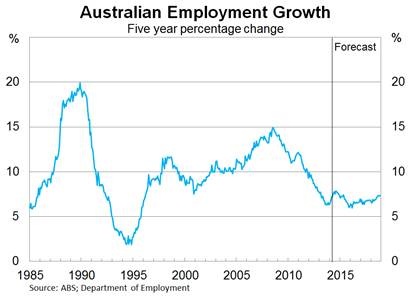There's no substance to the Coalition's attack on welfare
It is difficult to view cuts to unemployment benefits as anything less than an attack on welfare recipients. Particularly when the government itself doesn’t believe that its budget measures will boost employment.
Back in March, the Department of Employment released its employment estimates for the next five years. It estimates that employment will rise by 838,100 over the five years to November 2018, growth of 7.3 per cent compared with employment in November 2013 (The shaky foundations of the Coalition’s ‘powerhouse economy’, March 31). These estimates were well short of Tony Abbott’s pledge to generate one million jobs over the next five years.

At the time, the Department of Employment report was at pains to explain that it may understate employment growth. It noted that the projections “may not fully take account of the government’s policies to boost employment growth, including reducing red tape costs, lowering the company tax rate and abolishing the carbon and mining taxes”.
With the budget out, I can safely say that the Department of Employment need not have worried. The federal government’s own estimates suggest that its efforts to raise employment growth will, in fact, have next to no impact.
The employment estimates contained in the budget are entirely consistent with the earlier estimates from the Department of Employment. The budget estimates for the participation rate and unemployment rate square away nicely with a continuation of the recent strong population growth.
Effectively, there is nothing new in the budget papers that is likely to boost employment noticeably.
Under these circumstances, the decision by the federal government to push people off welfare is unusual. Self-sufficiency is great and should obviously be a goal where possible, but to achieve self-sufficiency people need to be able to find jobs and jobs need to exist.
Cutting benefits and tightening eligibility makes some sense when the economy is operating at around full employment. When jobs are plentiful, everyone who wants to work should be able to find a job relatively quickly. Even the long-term unemployed can find their way back into the workforce. In that situation, a prolonged period of unemployment is more about the individual than the economy.
But when the economy is subdued, as it is expected to be over the next few years, the blame shifts. Long-term unemployment has more to do with the economy than the individual. At this point of the economic cycle, welfare cuts are punishing some Australians for conditions that are outside their control.
For example, long-term unemployment as a share of total employment is at its highest level in 12 years. Long-term unemployment for young Australians is also elevated. Long-term unemployment represents economic problems rather than a sudden desire to be lazy.
There are obviously plenty of risks to the outlook for employment. I noted earlier this week that the exchange rate should begin to fall on the back of the terms of trade declining and capital inflows diminishing (The trends that will tame the Australian dollar, May 21). If this eventuates, then employment in the non-mining sector will be stronger than the estimates in the budget papers.
On the downside, a slowdown in China poses significant problems for the Australian economy. The estimates from the Department of Employment were also wildly optimistic for the mining sector.
The federal government’s employment estimates make a mockery of their claims that welfare cuts will force lazy Australians off the couch and into the workforce. Instead, the estimates predict that employment growth will be incredibly weak by historical standards and practically unchanged from estimates derived prior to the budget.
Given our high level of immigration and population growth, these employment estimates are extraordinary and point to an economy that will fail to generate sufficient opportunities for Australians. Welfare cuts during this period will prove counterproductive and would have been better delayed until the economy returned to trend growth.
















